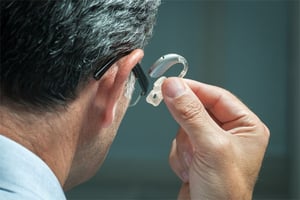Are My Hearing Aids Programmed Correctly?
Tags: Speech, Hearing Aid, Audiology, Hearing Aids, Communication, Hearing, Hard of Hearing
 As part of our dedication to ensure the best outcomes for our patients fit with hearing aids, CHSC audiologists complete two programming measures on all of our hearing aid patients.
As part of our dedication to ensure the best outcomes for our patients fit with hearing aids, CHSC audiologists complete two programming measures on all of our hearing aid patients.
Speech mapping, or Real Ear Measures (REM), is one objective verification method that we use to ensure that your hearing aids are programmed correctly. Think of your audiogram (the diagram of your hearing test results) like a road map. We know the destination – improved hearing – particularly of speech. We also know how we have programmed your hearing aid. Hearing aids really are like little computers – they are “listening “to your environments and automatically making changes based on the sounds they perceive and how they have been programmed. We want soft sounds to be audible, conversational level sounds comfortable, and loud sounds loud, but not uncomfortable.
Hearing aid programming is based on your audiogram and the assumption that the ear canal volume is an adult average of two cubic centimeters. The ear canal itself helps amplify or resonate certain tones. Just putting a hearing aid or ear mold into the canal affects that natural resonance. Think of a full soda bottle. When you blow into it you get a tone. When you drink half and blow into the bottle again you get a different tone. Every ear has its own unique shape, size, volume, and natural curves. And, right and left ears often don’t match – in shape or in ability!
So, we have a great start, with the audiogram “road map” and programming, but what we need to know is how the programming translates in YOUR EARS.
With REM, a tiny, jelly-like microphone and the hearing aids are placed together in each ear canal and calibrated. While the patient sits quietly, calibrated speech samples are played (the speech can be a woman’s, man’s or child’s voice) and the microphone records the result (ear by ear, pitch by pitch) at soft, conversational and loud speech levels so we can “see” if the programming has resulted in a good “speech audibility index”. Hearing aid programming can be adjusted “live” to meet expected targets.
2. The International Outcome Inventory for Hearing Aids (IOI-HA)
The IOI-HA is a subjective survey completed independently by the hearing aid user several weeks after the hearing aid fitting. The hearing aid user must have had experience with the aids in their own listening environments and sufficient time to adjust to the new levels of sound before the survey is completed. Together, the hearing aid user and the audiologist then review the answers for any items that may need further clarification or discussion and has proven to be an important part of counseling and ongoing success.
Please remember that the ongoing routine professional clean and check appointments at a minimum of every six months are also recommended. We want to see you!










